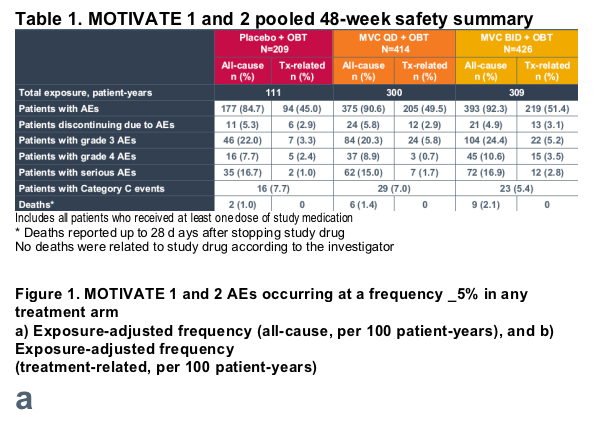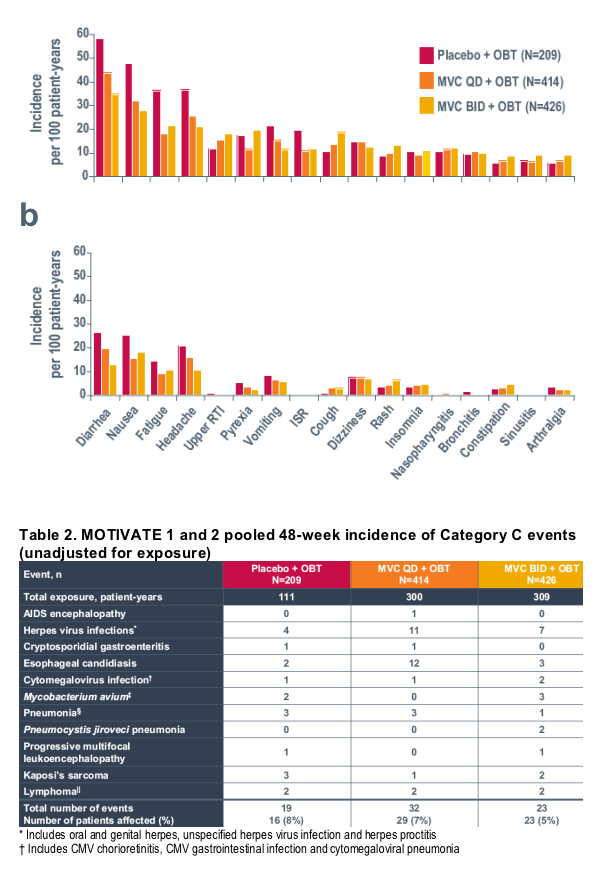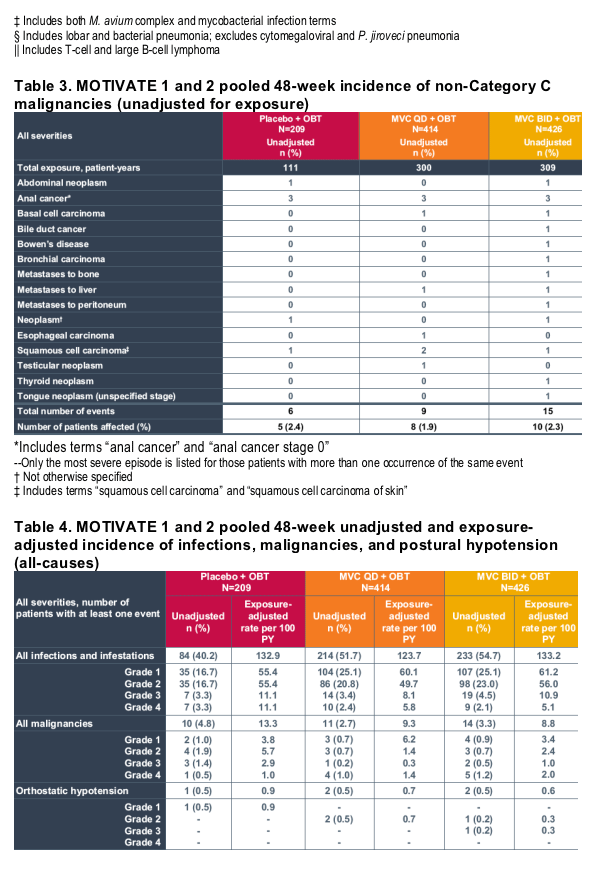 |
 |
 |
| |
Adverse Event Profile of Maraviroc in Treatment-experienced Patients Infected with R5 HIV-1
|
| |
| |
Reported by Jules Levin
ICAAC/IDSA Oct 28 2008 Wash DC
A Ayoub1, J Goodrich2, E van der Ryst1, J Heera2 and H Mayer2
1Pfizer Global Research and Development, Sandwich, UK; 2Pfizer Global Research and Development, New London, CT, USA
INTRODUCTION
Maraviroc (MVC; marketed as Celsentri/Selzentry) is a potent CCR5 antagonist approved for twicedaily (BID) administration as part of a combination antiretroviral (ARV) regimen in treatmentexperienced (TE) patients infected with CCR5-tropic (R5) HIV-1.
The efficacy and safety of MVC have been assessed in single- and multiple-dose studies in both healthy volunteers and HIV-infected patients, including the large Phase 2b/3 studies MERIT (MVC vs efavirenz, both with Combivir, in treatment-naive patients), MOTIVATE 1 (USA and Canada), and MOTIVATE 2 (Europe, Australia and USA).
In the MOTIVATE studies, adult TE patients with R5 HIV-1 infection, prior experience of or resistance to three ARV drug classes, and HIV-1 RNA >5,000 copies/mL, were randomized to receive placebo (PBO), MVC once daily (QD), or MVC BID, together with optimized background therapy (OBT) of 3-6 investigator-selected ARVs.1
In both studies, patients who received MVC (BID or QD) plus OBT demonstrated significantly greater virologic suppression and CD4+ cell count increases than those receiving PBO plus OBT.1
The mean Week 48 change from baseline in HIV-1 RNA (ITT) in the pooled MOTIVATE 1 and 2 studies was
-1.84 log10 copies/mL for MVC BID (46% <50 copies/mL) and -1.68 log10 for MVC QD (43% <50 copies/mL), vs -0.78 log10 for PBO (17% <50 copies/mL).
The mean change from baseline in CD4+ cell count (LOCF) in the pooled MOTIVATE 1 and 2 studies was +124 cells/mm3 for MVC BID and +116 cells/mm3 for MVC QD, vs +61 cells/mm3 for PBO.
We present here 48-week safety data from the combined MOTIVATE studies.
METHODS
Unadjusted and exposure-adjusted incidences of adverse events (AEs) of note were analyzed for 1,049 patients receiving MVC (QD or BID) or PBO over 48 weeks in the combined MOTIVATE 1 and 2 study datasets.
AEs of interest included Category C infections, hepatotoxicity including liver abnormalities, hypersensitivity (HSR) including rash, malignancies and postural hypotension (postural hypotension was the dose-limiting AE in Phase 1/2a studies of MVC).2
Subgroup analysis of AE data was performed by sex, age, race, CCR5delta32 status, and co-infection with hepatitis B (HBV) or hepatitis C (HCV) virus.
RESULTS
A summary of AE frequencies at Week 48 is shown in Table 1. Despite the longer total exposure to MVC plus OBT, caused by the higher rate of discontinuations in patients receiving PBO, both all-cause and treatment-related AE rates on MVC BID or QD were similar to the PBO arm.
Unadjusted incidences of serious AEs and grade 3/4 AEs were also similar between study arms, as was the proportion of AE-related discontinuations and deaths (Table 1).
Exposure-adjusted incidence rates for AEs that occurred in at least 5% of any treatment arm are shown in Figure 1a (all-cause) and 1b (treatment-related). The majority of AEs noted were not considered to be related to study drug.
Exposure-unadjusted rates of Category C events (Table 2) and non-Category C malignancies (Table 3) were low and similar between arms, other than a cluster of esophageal candidiasis events in the MVC QD arm that was not seen on MVC BID (Table 2).
A slightly higher exposure-adjusted incidence of all malignancies (Category C and non-Category C combined) was noted in the PBO arm (Table 4). Exposure adjusted rates of all infections and infestations were similar between arms and postural hypotension was rare (Table 4).
Overall, grade 3 and 4 elevations in liver function test results were uncommon (Table 5).
Higher rates of grade 3/4 AST and ALT elevations were seen in HCV co infected patients receiving MVC (Table 6). However, this does not take into account baseline values, which were unbalanced between arms. While this is an exposure-unadjusted analysis on a small sample, no effect on viral load or incidence or severity of adverse events was noted. Similarly, no effect on liver markers was seen for use of tipranavir in the OBT (Table 6).
Time to onset (Table 7) and mean duration (Figure 2) of adverse events of interest were similar between arms.
CONCLUSIONS
The safety profile of MVC in two large studies in treatment-experienced patients with few treatment options is similar to PBO.
MVC was not associated with increased rates or severities of infections, malignancies, Category C events, orthostatic hypotension, or clinically significant abnormalities in markers of liver function.
There were no differences in time to onset or duration of these AEs of interest between MVC and PBO arms, indicating no specific onset time and no effect of continued dosing on the incidence of such AEs.
Similar results were observed in treatment-naive patients in MERIT3 and in treatment-experienced patients with non-R5 infection in Study A4001029.4





REFERENCES
1. Hardy D, et al. 15th CROI. Boston, MA, February 3-6, 2008; Abstract 792
2. McHale M, et al. 3rd IAS. 2005; Abstract TuOa0204
3. Saag M, et al. 4th IAS. 2007; Abstract WESS104
4. Goodrich JM, et al. 45th IDSA. 2007; Abstract LB-2
|
| |
|
 |
 |
|
|